### How to Upgrade Your Old PC for Modern Gaming
Upgrading an old PC can be a cost-effective way to bring it up to speed with modern gaming requirements. Rather than building an entirely new system, targeted upgrades can rejuvenate your machine and provide smooth gameplay for the latest titles. In this guide, we’ll explore the steps and components to focus on when upgrading your aging PC for modern gaming.
---
#### **1. Evaluate Your Current System**
Before diving into upgrades, it’s important to assess your current PC’s components and identify bottlenecks. Tools like CPU-Z, HWMonitor, or Speccy can provide detailed information about your hardware. Start by evaluating key areas:
- **Processor (CPU):** Is it capable of handling newer games?
- **Graphics Card (GPU):** Does it meet the requirements of modern games?
- **RAM:** Do you have enough memory for gaming?
- **Storage:** Are your load times slow due to an older HDD?
- **Power Supply Unit (PSU):** Can it handle upgraded components?
- **Cooling System:** Is it sufficient for new hardware?
Understanding where your system falls short will help you prioritize upgrades based on your budget and gaming needs.
---
#### **2. Upgrade the Graphics Card (GPU)**
The GPU is often the most critical component for gaming performance. If your current GPU struggles with modern titles, upgrading to a newer model can significantly improve frame rates and visual quality. When selecting a new GPU, consider:
- Compatibility with your motherboard (check the PCIe slot and available space in your case).
- Power requirements (ensure your PSU has enough wattage and the necessary connectors).
- Your monitor’s resolution and refresh rate (higher resolutions and refresh rates demand more powerful GPUs).
Mid-range GPUs, such as NVIDIA’s GeForce RTX series or AMD’s Radeon RX series, offer excellent performance for 1080p and 1440p gaming without breaking the bank.
---
#### **3. Add More RAM**
Modern games often require 16GB of RAM for optimal performance, whereas older PCs might only have 8GB or less. If your motherboard has empty RAM slots, adding more memory is a straightforward upgrade. Be sure to:
- Match the type (e.g., DDR3, DDR4) and speed of your current RAM.
- Install dual-channel memory for better performance.
- Check your motherboard’s maximum supported RAM capacity.
For multitasking or running demanding applications alongside games, upgrading to 32GB can offer even greater benefits.
---
#### **4. Switch to an SSD**
Storage is a common bottleneck in older PCs. Replacing an HDD with an SSD drastically improves boot times, game load speeds, and overall system responsiveness. NVMe SSDs, in particular, provide the fastest speeds, but even a standard SATA SSD is a significant upgrade over an HDD.
Consider using a dual-drive setup: an SSD for your operating system and games, and an HDD for bulk storage. This ensures you get the best of both speed and capacity.
---
#### **5. Upgrade the CPU and Motherboard**
If your processor is outdated and holding back your GPU, it’s time for an upgrade. Upgrading the CPU often necessitates a new motherboard, especially if your current socket is no longer supported. When selecting a CPU and motherboard:
- Ensure compatibility with your existing components, such as RAM and the case.
- Choose a CPU that aligns with your gaming needs (e.g., a high single-core performance for gaming).
- Look for a motherboard with modern features like PCIe 4.0/5.0, USB-C, and multiple M.2 slots for future-proofing.
While this upgrade can be more involved, it’s essential for keeping up with modern gaming requirements.
---
#### **6. Enhance Cooling and Airflow**
Upgraded components often generate more heat, so it’s essential to improve your cooling system. Clean out dust from your case and fans, and consider upgrading your CPU cooler if temperatures run high. Additional case fans or an all-in-one (AIO) liquid cooler can help maintain optimal temperatures during intense gaming sessions.
---
#### **7. Replace the Power Supply Unit (PSU)**
Upgrading to a more powerful GPU or CPU may require a higher-wattage PSU. Choose a reliable PSU with an 80+ Gold efficiency rating to ensure stable power delivery and prevent hardware issues. Modular PSUs are also a great option for better cable management.
---
#### **8. Install the Latest Drivers and Updates**
After upgrading your hardware, don’t forget to update your drivers and firmware. GPU drivers, motherboard BIOS updates, and operating system patches ensure compatibility and optimal performance. Keeping your software up to date is just as important as upgrading your hardware.
---
#### **Conclusion**
Upgrading your old PC for modern gaming doesn’t have to be overwhelming. By focusing on key components like the GPU, RAM, and storage, you can achieve significant performance gains without the cost of a new build. With careful planning and incremental upgrades, your old PC can keep up with the demands of today’s gaming landscape and provide an excellent experience for years to come.
How to Upgrade Your Old PC for Modern Gaming
Upgrading an old PC can be a cost-effective way to bring it up to speed with modern gaming requirements.
View our related products
See more



Related Articles
Essential High-Performance PC Components You Need Now
Upgrade your setup with the must-have parts for unbeatable gaming and productivity
Top Picks for Best High-Performance PCs
Find the perfect power machine for gaming, work, or creative projects
Your Guide to the Best High-Performance PCs
Find the Right PC for Your Gaming and Creative Needs
View our related products
See more





